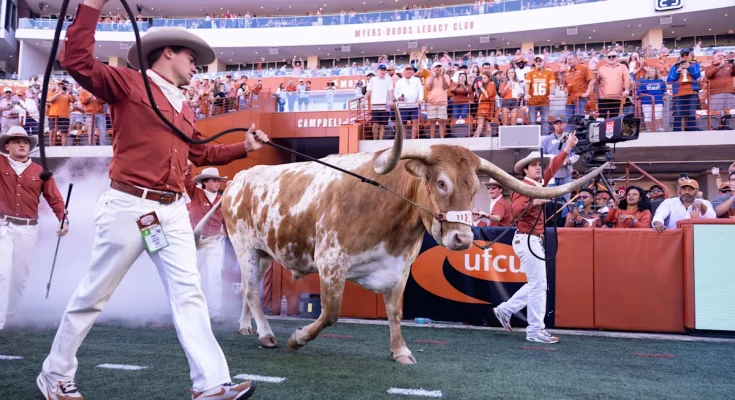There are mascots, and then there’s Bevo. Towering, powerful, and iconic, the Texas Longhorns’ beloved live mascot isn’t just a sideline figure—he’s an institution. In a realm where character counts, tradition speaks volumes, and fan bases rally behind their symbols with fiery devotion, Bevo has managed to transcend the boundaries of mere representation. His dominance isn’t just about his size or long, curving horns that stretch six feet wide—it’s about presence, attitude, and cultural significance. As college football evolves and rivalries intensify, Bevo stands tall—literally and metaphorically—as the supreme mascot in the sport, toppling the likes of LSU’s Mike the Tiger and Georgia’s UGA with unmatched swagger and spirit.
Bevo isn’t new to the scene, but his reign has taken on new meaning in today’s highly visible and media-driven landscape. While other mascots play roles at games or parade through tailgates, Bevo brings with him a regal, almost mythic energy. Since his first appearance in 1916, he’s been a symbol of Texas pride—raw, untamed, and fiercely loyal. But what elevates Bevo to royalty isn’t just the longevity of his lineage or the way he commands attention when he enters the stadium; it’s the embodiment of an entire state’s attitude—resilient, bold, and unapologetically proud.
To compare mascots is to step into a world filled with passion and tradition. UGA, the perpetually photogenic bulldog from Georgia, exudes southern charm and has his own air-conditioned doghouse. Mike the Tiger roars from his luxury enclosure at LSU, a literal apex predator symbolic of the ferocity of the Tigers’ football brand. Both are revered, deeply tied to their programs, and beloved by their fans. But neither walks into a stadium on a rope led by seasoned handlers and causes the kind of collective goosebumps Bevo does. Neither is as intertwined with their school’s ethos quite like Bevo is with the University of Texas. He is Texas—unbridled, determined, intimidating, and majestic.
The swagger Bevo carries is not performative—it’s innate. When he’s paraded onto the field at Darrell K Royal-Texas Memorial Stadium, all eyes lock on him. The band plays, the crowd roars, and Bevo takes it all in, cool and composed. His entrances are less about performance and more about proclamation. He doesn’t need to jump around or do backflips; he just stands there, horns up, sending a clear message: this is Texas, and we do things bigger and better.
Few mascots have captured the national spotlight like Bevo has. Who could forget the tense moment in 2019 at the Sugar Bowl when Bevo charged toward UGA, creating one of the most viral mascot moments in recent history? That unplanned burst of energy reminded everyone that Bevo is not just an ornamental figure—he’s alive, spirited, and untamed. That moment wasn’t just an incident—it was a metaphor. It was Texas saying, “We’re not here to play nice. We’re here to take over.”
Bevo’s spirit is woven into the pageantry of college football. Unlike most other mascots, he doesn’t come with a manufactured costume or act. He is authentic, a living, breathing embodiment of Longhorn grit. His caretakers, known as the Silver Spurs, are entrusted with preserving his dignity and ensuring his comfort and safety. Their respect for him is evident—this is not just a mascot; it’s a legacy. And that legacy is steeped in reverence and tradition, not just from the university, but from the entire state.
Mike the Tiger has his grandeur. Housed in a multi-million dollar habitat and revered as one of the most impressive live mascots in college football, Mike represents power and fearlessness. But Mike is mostly a solitary figure, watched from afar, separated from fans by barriers. He is more symbol than participant, more exhibit than teammate. UGA, though a charming and heartwarming presence, is cuddled, pampered, and made for Instagram. He’s cute, no doubt, but his image leans toward endearing rather than commanding.
Bevo, on the other hand, strikes awe. He is approachable but not too approachable, loved but still respected. Fans line up for pictures, not to pet a fuzzy friend, but to stand near royalty. He doesn’t just exist within the Texas program—he looms over it like a guardian of legacy and a herald of dominance. His image is emblazoned on jerseys, merchandise, murals, and flags. The silhouette of his head is immediately recognizable, even by casual fans. That’s influence. That’s supremacy.
What makes Bevo even more compelling is how he’s managed to stay relevant and iconic in an age where branding and social media have diluted the power of tradition for many programs. Some mascots come and go, redesigned to appeal to younger audiences or rebranded for marketing campaigns. Bevo doesn’t need that. He hasn’t changed because he doesn’t need to. He represents a timeless pride that doesn’t bend to trends. That kind of staying power is rare, and it’s one of the strongest indicators of true greatness.
The stories around Bevo further add to his mystique. From the myth surrounding his name—an apparent rebranding of the word “beef” with a touch of 20th-century Texan creativity—to tales of him standing unfazed in front of hostile crowds, every anecdote about Bevo contributes to his folklore. He’s not just a part of Texas history; he is Texas history. He was there when the Longhorns won national titles, when Heisman winners like Earl Campbell and Ricky Williams roamed the field, and during every era of transition, pride, and glory the program has endured.
There’s also something poetic about Bevo’s presence during moments of both triumph and heartbreak. When Texas wins, Bevo is the majestic symbol of victory. When Texas loses, he remains, steady and unshaken, a constant source of pride and tradition. His role doesn’t fluctuate with the scoreboard—his significance is eternal.
In rivalries, Bevo’s dominance is also felt. Whether it’s the Red River Rivalry against Oklahoma or matchups with SEC giants, Bevo’s looming presence can often intimidate before the opening kickoff. He represents not just a program, but a mentality. He’s not afraid of noise, cameras, or confrontation. He stares down chaos and remains stoic. That kind of energy resonates deeply with a fan base that prides itself on doing everything “the Texas way.”
Mascots are meant to embody the soul of a school. In that sense, Bevo is flawless. He captures everything the University of Texas wants the world to know—strength, prestige, authenticity, and a bit of edge. There’s no gimmick, no costume to hide behind, no exaggerated antics. Just Bevo, standing tall under the Texas sun, horns gleaming, gaze unwavering.
Even in the face of expanding college football playoff systems, conference realignments, and changes in the fabric of college sports, Bevo remains an unshakable constant. His royalty doesn’t need validation from committees or rankings. He’s been on national TV, featured in commercials, and recognized by sports legends, but none of it defines him. What defines Bevo is the raw, unmatched energy he brings to the game. What defines him is the respect he commands without saying a single word.
As conversations continue around the best mascots in college football, Bevo’s name doesn’t just come up—it sits at the top. He’s more than just the face of Texas athletics; he’s the pulse. Where Mike the Tiger reigns behind glass and UGA snoozes in comfort, Bevo reigns from the turf. The Longhorn Nation doesn’t just cheer for him—they revere him. They recognize that in a game built on grit, passion, and legacy, there can only be one king. And Bevo, regal and unyielding, wears that crown proudly.



